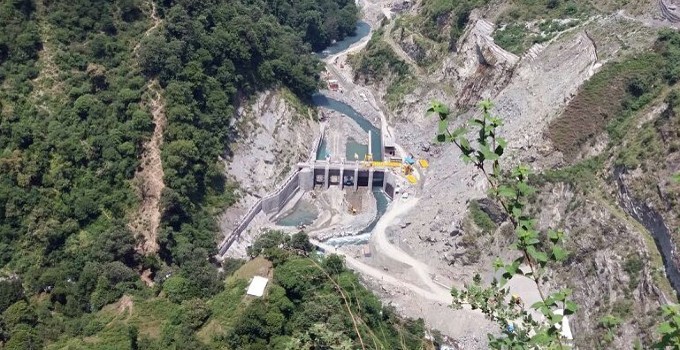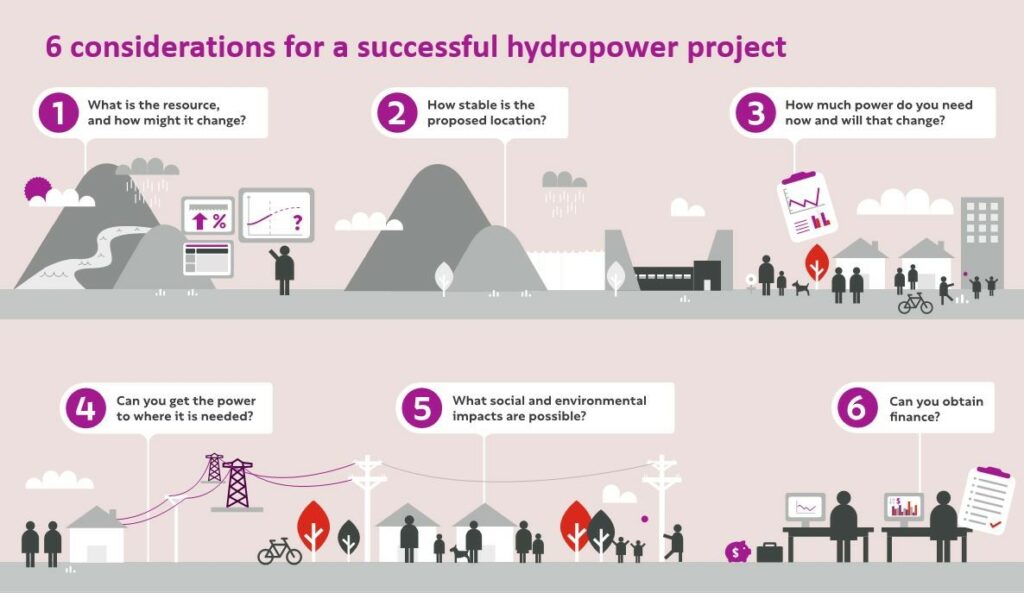THOUGHT LEADERSHIP
Is there still a role for run-of-river hydropower projects?
In 2000, a major report by the World Commission on Dams shone a spotlight on large dams. At that time, some people argued that smaller, run-of-river hydropower could be a more sustainable solution than large dams with large reservoirs. Is this true? And is it still relevant more than twenty years on?

Run-of-river hydropower projects have little or no storage, which means that they don’t require the construction of a large dam, and don’t need to inundate a significant area with a large reservoir storage. Run-of-river hydropower may therefore have lower social and environmental impacts. A diversion weir is less likely to be a barrier to sediment transport, fish passage, or navigation; however, because run-of-river hydropower still involves constructing a structure in the river, these schemes are unlikely to have zero environmental impact. It is interesting to note that run-of-river hydropower projects and other small projects that do not involve the construction of large dams account for more than half of the hydropower projects supported by the World Bank.
Despite potentially having a lower environmental and social impact, run-of-river projects do have a significant disadvantage compared to large reservoir hydropower. For run-of-river projects, not all of the energy is ‘firm’, as the ability to generate depends on the availability of flow in the river. If a river catchment is highly responsive to rainfall, the daily variation of generation from a run-of-river hydropower scheme could be highly variable (similar to wind and solar).
If annual rainfall is highly seasonal, with a dramatic wet season and dry season, then a run-of-river hydropower scheme will generate much more power when seasonal river flows are high, and significantly less during drier months. So a run-of-river scheme will not necessarily be able to play the increasingly important role of firming variable renewables, and is more likely to be considered an additional source of variable renewable energy.
Run-of-river may not offer storage, but it can still have a place
But this doesn’t mean there’s no longer a place for run-of-river hydropower, as it is still a valuable and clean form of energy. In some situations, the lack of firming capacity doesn’t necessarily matter too much due to the existing diversity within the generation portfolio, or the type of generation that is being displaced. Run-of-river hydropower can still be a viable option in these circumstances:
- where the run-of-river hydro scheme is part of a larger portfolio of hydropower assets, which already has storage within the overall system – in this situation, the various hydropower generation assets can be operated together as a dynamic, integrated system, using the various assets to deliver an optimum output
- where the run-of-river hydro scheme is part of a diverse portfolio of variable renewables, including solar, wind and run-of-river hydro – in this case, it is unlikely that the mix of variable renewables will be highly correlated (i.e. it is unlikely that when there is no water in the river, there is also no wind or sun), and therefore less energy storage will be required to firm the variable generation
- where the run-of-river hydro is displacing expensive thermal generation – such as the displacement of diesel-powered generation on an island or a remote off-grid site.
Achieving sustainable storage
If there is potential to add storage to a hydropower scheme in a sustainable manner, then this is likely to create more long-term value, especially in an escalating clean energy transition. Storage will make the hydropower more flexible, agile and responsive, and able to ‘firm’ more variable renewable energy sources. With storage, hydropower can match generation with the demand for electricity. Essentially, storage can ‘unlock’ more renewables, and underpin a faster energy transition.
But the key is to make sure that any larger-scale hydropower projects with storage are developed right. In a previous article, we argued that a successful hydropower project requires:
- understanding the current water resource and how it might change – and building in climate resilience
- thoroughly investigating the geological and geotechnical conditions
- projecting future demand in the context of industrial development and population change
- getting the power to where it is needed through appropriate transmission and distribution infrastructure
- carefully considering the project’s stakeholders, community and environment
- securing project finance.

All of these aspects contribute to minimising risks throughout the project lifecycle and increasing the sustainability of the project in the long term, so that it can deliver social, environmental and economic benefits.
The best way to ensure that your hydropower project is developed in a sustainable manner, from the earliest stages of consideration through to operation and end-of-life, is by applying the international Hydropower Sustainability Standard.
Talk to us about achieving the right mix of renewables for your needs, and getting hydropower projects right.
About the author
Richard Herweynen is Entura’s Technical Director, Water. Richard has three decades of experience in dam and hydropower engineering, and has worked throughout the Indo-Pacific region on both dam and hydropower projects, covering all aspects including investigations, feasibility studies, detailed design, construction liaison, operation and maintenance and risk assessment for both new and existing projects. Richard has been part of a number of recent expert review panels for major water projects. He participated in the ANCOLD working group for concrete gravity dams and is the Chairman of the ICOLD technical committee on engineering activities in the planning process for water resources projects. Richard has won many engineering excellence and innovation awards (including Engineers Australia’s Professional Engineer of the Year 2012 – Tasmanian Division), and has published more than 30 technical papers on dam engineering.
MORE THOUGHT LEADERSHIP ARTICLES
12 December, 2022






